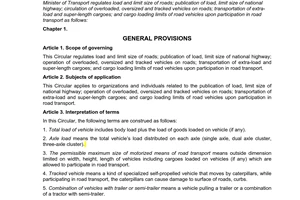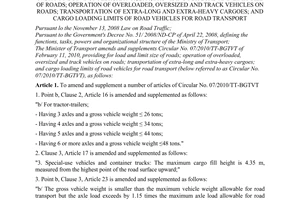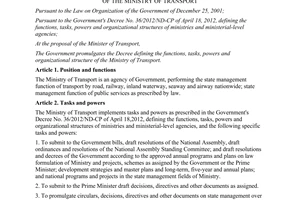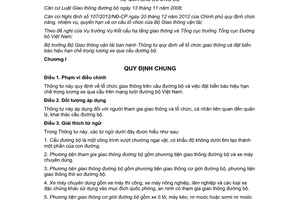Nội dung toàn văn Circular No. 84/2014/TT-BGTVT regulations on traffic organization
|
THE MINISTRY OF TRANSPORT |
SOCIALIST REPUBLIC OF VIETNAM |
|
No. 84/2014/TT-BGTVT |
Hanoi, December 31, 2014 |
CIRCULAR
REGULATIONS ON TRAFFIC ORGANIZATION AND PLACEMENT OF WEIGHT LIMIT SIGNS FOR ROAD VEHICLES CROSSING BRIDGES
Pursuant to the Law on Road traffic dated November 13, 2008;
Pursuant to the Government's Decree No. 107/2012/NĐ-CP dated December 20, 2012, defining the functions, tasks, entitlements and organizational structure of the Ministry of Transport;
At the request of Director General of Department of Transport Infrastructure and Director General of Vietnam Road Administration;
The Minister of Transport promulgates the Circular regulating traffic organization and placement of weight limit signs for road vehicles crossing bridges.
Chapter I
GENERAL PROVISIONS
Article 1. Governing scope
This Circular regulates traffic organization and placement of weight limit signs for road vehicles crossing bridges throughout road network in Vietnam.
Article 2. Regulated entities
This Circular applies to road users, and organizations, individuals involved in the management and operation of roads.
Article 3. Interpretation of terms
In this Circular, some terms are construed as follows:
1. Road bridges mean the works that provide passage over physical obstacles with spans of below six meters as part of a road.
2. Road vehicles include means of road transport and specialized vehicles.
3. Means of road transport mean road motor vehicles and non-motorized vehicles.
4. Specialized vehicles include work vehicles, agricultural and forestry vehicles, and other types of specialized vehicles used for National defense and security and participating in road traffic.
5. Road motor vehicles include automobiles, tractors, trailers or semi-trailers pulled by automotive vehicles, tractors; two-wheeled, three-wheeled motor vehicles; motorbikes (including powered bikes) and similar vehicles.
6. Monocoque body vehicle means a type of vehicle in which the body is integral with the chassis
7. Tractor-trailer means the combination of a tractor unit and one or more semi-trailers to carry freight.
8. Gross vehicle weight includes weight of the vehicle itself, passengers and cargo.
10. Gross axle weight means total vehicle weight that is distributed on each axle (single axle, double-axle, triple axle)
11. Basic length of vehicle means the distance from the first wheel axle to the last wheel axle of the vehicle or combination of vehicles.
12. Bridge load capacity means permissible load capacity of a bridge to ensure safe and sustainable operation of the bridge. Bridge load capacity is determined according to design documentation and actual technical conditions of the bridge, announced by competent agencies or described in bridge signs.
13. Bridge length means horizontal length of the bridge between two abutments
14. Bridge management agencies or units include regional road management bureaus, the Services of Transport, People’s committees of districts, People’s Committees of communes, investors and other agencies assigned by competent authorities.
15. Circular No. 07/2010/TT-BGTVT means the Minister of Transport’s Circular No. 07/2010/TT-BGTVT dated February 11, 2010 regulating load capacity, dimensional limits of roads, circulation of overloaded, oversized, and tracked vehicles on road; transportation of extra-load and super-length cargoes; and cargo loading limits of road vehicles upon participation in road transport that is amended, supplemented in Circular No. 03/2011/TT-BGTVT dated February 22, 2011 and Circular No. 65/2013/TT-BGTVT dated December 31, 2013.
Chapter II
ORGANIZATION OF TRAFFIC ON ROAD BRIDGES
Article 4. Principles of traffic organization on bridges
Organization of traffic on road bridges must be in compliance with principles of road traffic as prescribed in Chapter II of the Law on Road traffic in 2008 and following principles:
1. Road vehicles crossing a road bridge must travel on the right and lanes as prescribed; follow instructions provided by traffic conductors and road signs set up in front of the bridge.
In case road signs are not available, provisions set out hereof and by the Minister of Transport on vehicle weight, dimensional limits, speed and safety distance between vehicles;
2. Do not stop or turn around vehicles (except vehicles or equipment of bridge management and maintenance units); any vehicle that breaks down unexpectedly should be moved out of the bridge range.
3. Non-motorized vehicles, pedestrians or controlled animals must travel on the lanes as prescribed.
Article 5. ORGANIZATION OF TRAFFIC ON BRIDGES
1. MODE OF ORGANIZATION OF TRAFFIC ON BRIDGES
a) No-control mode: Any road vehicle that meets requirements as prescribed in Articles 16, 17 and 18 of Circular No. 07/2010/TT-BGTVT shall be permitted to travel across bridges if signs are not available (except bridge information signs);
b) Control mode: Any road vehicle that meets requirements as prescribed in Articles 16, 17 and 18 of Circular No. 07/2010/TT-BGTVT shall be permitted to travel across bridges but must be in compliance with the signs set up in front of bridges.
c) Special control mode: Any road vehicle that is beyond requirements as prescribed in Articles 16, 17 and 18 of Circular No. 07/2010/TT-BGTVT or has vehicle weight, dimensional limits beyond value as prescribed in the signs set up in front of the bridge must obtain permit from competent agencies before traveling across the bridge. In this case, rules as prescribed in the permit or instructions by traffic conductors must be complied with or other measures (if necessary) to ensure bridge safety.
2. Upon any incident causing loss of safety to traffic and bridge, bridge management agencies must take urgent measures to ensure traffic and bridge safety. In case of restrictions or prohibition of crossing bridges, bridge management agencies must instruct, direct and regulate traffic across bridges in accordance with technical conditions of bridges to ensure traffic and bridge safety, safety to people and vehicles crossing bridges.
3. Traffic activities on bridges shall be directed by bridge management agencies in combination with functional agencies, other forces within assigned role and responsibility.
Article 6. Bridge signs
1. Bridge load limits signs as prescribed in QCVN 41:2012/BGTVN - National technical regulation on road signs enclosed with the Minister of Transport’s Circular No. 17/2012/TT-BGTVT dated May 29, 2012 (hereinafter referred to as QCVN 41:2012/BGTVT)
a) No. 115 Sign “Restrictions for vehicle weight”: Prohibit types of road vehicles with gross vehicle weight exceeding value described on the signs;
b) No. 106a Sign “Trucks prohibited” enclosed with secondary No. 505b Sign “Types of vehicles restricted” (See Appendix 1 enclosed herewith): Prohibit road vehicles with gross vehicle weight exceeding value described on the signs;
b) No. 106a Sign “Trucks prohibited” enclosed with secondary No. 505c Sign “Axle weight restricted”: Prohibit road vehicles with gross vehicle weight distributed on axles exceeding value described on the signs.
2. Signs of instructions and organization of traffic crossing bridges
To regulate and instruct traffic crossing bridges in case of need, additional installation of No. 121 Sign “Minimum distance between two vehicles”, No. 127 Sign “Permissible maximum speed” and other road signs according to QCVN 41:2012/BGTVT must be carried out.
3. Bridge information signs
a) No. 439 Sign “Bridge name": only for bridges with length from 30 meters and over; Bridge name signs should not be installed to iconic bridges and bridges inside urban areas (inside cities, district-level towns) unless bridges have names associated with cultural and historical place-names Bridge name signs shall be placed at two ends of a bridge with a distance of 10 meters from abutment to the right side of the road.
b) Sign “Bridge management information” is attached to bridge beams close to path of access for bridge examination. Bridge management information includes bridge name, name or number of roads, design load capacity, bridge length and year of construction.
Chapter III
PLACEMENT OF WEIGHT LIMIT SIGNS
Article 7. PLACEMENT OF WEIGHT LIMIT SIGNS
1. Bridges that do not require placement of weight limit signs
a) Bridges that are designed with weight bearing capacities of advanced standards (H30-XB80, HL93 or similar)
b) Bridges that are in operation, calculated or examined to have met weight bearing capacities similar to standards as prescribed in Point a of this Clause.
2. Bridges that require placement of weight limit signs
a) Bridges that do not guarantee requirements as prescribed in Clause 1 of this Article;
b) Value as described on the signs is results of calculation or examination of bridges and round to unit of ton and decided by competent authorities as prescribed in Clause 4, Article 8 hereof.
3. Uniformity in weight bearing capacity of bridges, roads across the road network
a) When a new bridge is put into construction, it should be designed according to 22TCN 272-05 standard (or similar weight limits)
b) When a bridge is renovated or upgraded, it must be designed toward increasing weight bearing capacity or in combination with traffic organization and placement of weight limit signs when possible (maximum speed, one by one crossing, minimum distance between vehicles...).
c) For bridges of low weight bearing capacity (only for vehicles under 13 tons in gross vehicle weight) on national road network, a new bridge must be built as a replacement in case of need and construction of new bridges on other road networks must be planned in accordance with socio-economic development plan in localities.
Article 8. Management of placement of weight limit signs
1. Placement of weight limit signs
a) Weight limit signs must be placed for every bridge to the right side of the road with a distance of from 10-30 meters from two ends of the bridge at a position of good visibility.
b) In case a bridge breaks down unexpectedly or has low weight bearing capacity, in addition to the placement of weight limit signs as prescribed in Point a, Clause 1, Article 6 hereof, additional signs of instructions on positions of lowest weight bearing capacity must be placed at two ends of the bridge.
2. Responsibilities for placement of weight limit signs
a) Road Management Department: national road network as assigned
b) The Services of Transport: entrusted national road network and local road networks as assigned
c) People’s committees of districts, People’s Committees of communes and other agencies, units: local road networks assigned by competent authorities.
d) Investors: PPP, BOT projects or specialized roads
3. Inspection, investigation and calculation of weight bearing capacity of bridges
a) Bridge management agencies shall be responsible for checking and making decisions on bridges that need to be placed with weight limit signs.
b) Investigation and calculation of weight bearing capacity to determine value must be carried out before weight limit signs are placed.
c) Inspection, investigation and calculation of weight bearing capacity or examination of bridges shall be carried out by a qualified professional consultant; In case of need, an independent consultant can be hired to inspect the tasks carried out by the professional consultant.
4. Powers to make decisions on value to be described on weight limit signs
a) Vietnam Road Administration shall make decisions for bridges on national road network (including PPP, BOT projects)
b) The Services of Transport shall make decisions for bridges on local road network within administrative divisions under management (including PPP, BOT projects and specialized roads).
5. In case a key weight bearing structure of a bridge breaks down unexpectedly, bridge management agencies shall carry out inspection and investigation to determine the value and place a temporary sign of weight limits or carry out immediate regulation of traffic, and at the same make a written request to competent authorities for permission to carry out urgent repair work to ensure safety to traffic and bridge work.
Chapter IV
IMPLEMENTATION
Article 9. Implementation
1. Vietnam Road Administration shall direct the placement of weight limit signs across the country.
2. Regional Road Management Department and the Services of Transport shall instruct and inspect placement of weight limit signs on local road network and specialized roads within administrative divisions under management.
3. Regional Road Management Department (national road network), the Services of Transport (local road network) shall be responsible for updating bridges for weigh limits, dimensional limits and making public announcement on the website, and at the same time make the report to Vietnam Road Administration for early updating and making public announcement across the country.
4. Annually, Vietnam Road Administration shall compile checking, adjustment and announcement of weight bearing capacity of bridges and make the report to the Ministry of Transport before March 31 the following year.
Article 10. Implementary provisions
1. This Circular takes effect since March 01, 2015.
2. 505b Sign “Types of vehicles restricted” as prescribed in Appendix F of QCVN 41:2012/BGTVT shall be superseded by 505b Sign “Types of vehicles restricted” as prescribed in Appendix 2 enclosed herewith.
3. Documents that are amended, supplemented from or replace legislative documents as cited in this Circular shall be applied instead.
4. Chief of the Ministry Office, Chief Inspector, director generals of Vietnam Road Administration, Director of Road Management Department, directors of the Services of Transport, heads of relevant agencies, organizations and individuals shall be responsible for executing this Circular.
5. Difficulties that arise during the implementation of this Circular should be reported to the Ministry of Transport, Vietnam Road Administration for instructions. /.
|
|
THE MINISTER |
------------------------------------------------------------------------------------------------------
This translation is made by LawSoft and
for reference purposes only. Its copyright is owned by LawSoft
and protected under Clause 2, Article 14 of the Law on Intellectual Property.Your comments are always welcomed




